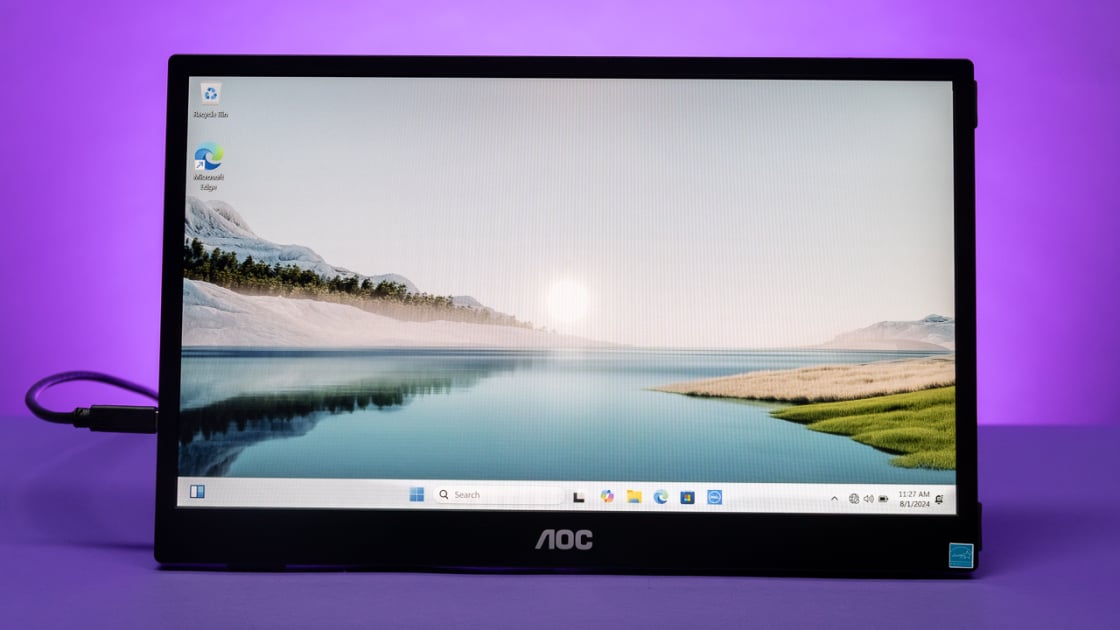
The AOC 16T3EA ($129.99) is a low-priced portable monitor that’s among the most physically versatile out there. Its stand supports placing the display in either portrait or landscape mode, and an included VESA bracket lets you mount the panel to an arm or a wall if you have a compatible mount. A 1080p IPS screen offers good contrast, but color coverage is limited, and a single USB-C port handles both power and signal (data and video) from your computer. So the 16T3A is only worth considering over the Editors’ Choice-winning ViewSonic VG1655 if you don’t need multiple connectivity options and are limited to a sub-$150 budget.Design: Flexible Stand, USB-Only InterfaceCompact and lightweight, the 16T3EA measures 9 by 14.3 by 0.5 inches (HWD) and weighs just 1.8 pounds, making it easy to take to a coffee shop or a conference. It comes with a cloth sleeve decorated with a hexagon pattern, which can be used for storage and basic protection while traveling. The 16T3EA’s chassis has a matte-black front with fairly thin bezels, which frame a 15.6-inch (diagonal) in-plane switching (IPS) screen with a resolution of 1,920 by 1,080 pixels (aka Full HD, FHD, or 1080p) and a 16:9 widescreen aspect ratio that matches most laptops. It supports wide vertical and horizontal viewing angles of up to 178 degrees, which means that one can view the screen from an extreme angle without significant degradation in brightness or color.
Since 1982, PCMag has tested and rated thousands of products to help you make better buying decisions. See how we test.
On the left edge of the 16T3EA’s screen is a USB-C port, the monitor’s only connector. This upstream port, which supplies both power and signal (data and video) from a computer, supports DisplayPort over USB Alternate Mode and power delivery of up to 15W.
(Credit: Joseph Maldonado)
We prefer that monitors have multiple connectivity options—many portable monitors add a mini HDMI connector—or at least a second USB-C port so that the display can be connected to a power adapter if need be.
(Credit: Joseph Maldonado)
On the back of the 16T3EA, which is decorated with a pattern of tiny gray dots, are two fold-out panels that act as stands, one to support the monitor in landscape orientation and one to prop it up for portrait mode.
(Credit: Joseph Maldonado)
They feel reasonably sturdy, though their tilt angle is limited so that the top of the screen is tilted slightly back from the viewer. Still, they are an improvement over the folding, origami-style stands that come with some other budget portable monitors. And the 16T3EA also comes with a VESA bracket, which can be screwed into four holes in the back of the monitor for attachment to a VESA mount so that the display can be arm- or wall-mounted.
(Credit: Joseph Maldonado)
On top of the 16T3EA, to the right, are four small buttons: one for power, two arrow buttons, and one button labeled OK. The OK button can be used to lock in settings, but it has a more fundamental purpose: You need to press it twice to access the monitor’s on-screen display (OSD). Once I figured that out, OSD navigation was simple enough. However, I prefer the mini-joystick style controller that we occasionally see on portable monitors (usually more expensive ones) to the tiny buttons.Testing the AOC 16T3EA: Limited Color CoverageI tested brightness, contrast, and color coverage using a Klein K10-A colorimeter and Portrait Displays’ CalMAN Ultimate for Business software. AOC rates the 16T3EA’s luminance at 250 nits (candelas per square meter); in my testing, it came up a bit short of that at 211 nits, nevertheless a typical brightness for a budget portable monitor.The 16T3EA’s advertised contrast ratio is 700:1; I measured it at a considerably better 1,045:1. Most competitors have rated contrast ratios between 600:1 and 1,000:1.
(Credit: Portrait Displays)
The A1 showed mediocre sRGB color coverage, typical of budget portable monitors, covering 64.7% of that space in my testing (see the chromaticity chart above). The triangle represents the colors that comprise sRGB—essentially, all the colors that can be made by mixing different percentages of red, green, and blue. The white boxes show where the data points would be for a monitor that covers the full sRGB space, and the circles represent our own measurements. Several of our test points are well within the triangle, showing a crimped color gamut, particularly in the red, orange, and pink part of the range. Notice, though, that the blue circle is slightly outside of the triangle.This pattern is very familiar, as we have seen it on 1080p IPS screens from numerous portable monitors introduced since 2019—most of these panels likely come from the same source. Although color coverage in midrange and high-end portable monitors has generally been much better in the past three years, usually exceeding 90% for sRGB, we still often see budget monitors with color coverage similar to the 16T3EA (in the 60%-to-65% sRGB range); other recent examples include the MSI Pro MP161 E2 and the Arzopa A1. This means that although the 16T3EA is not great for entertainment or photo work, it’s fine for general-purpose personal and business use. Our formal image testing, in which I viewed our selected film clips and our photo suite on the 16T3EA, confirms this. The monitor is usable, though not ideal, for watching videos or looking at photos. In both photos and videos, colors seemed a touch muted, with reds looking a bit orange and greens often appearing yellowish. The monitor did do well in showing detail in both light and dark areas.Verdict: A Highly Portable, Low-Priced Second ScreenFor just over $100, the AOC 16T3EA is a lightweight and highly portable second screen to add to your on-the-go laptop setup. Its unusual stand lets you use the monitor in either portrait or landscape mode, and it even includes a VESA bracket for wall mounting. Image quality, with good contrast but mediocre color coverage, is typical of low-priced portable displays. If you want a portable monitor with wider color coverage, you may have to pay a bit more. The LG Gram +View is a good choice, offering full sRGB and Adobe RGB coverage, and the ViewSonic VX1655-4K-OLED provides a sweet OLED screen and excellent sRGB, Adobe RGB, and DCI-P3 color coverage, though it will cost you half a grand.
(Credit: Joseph Maldonado)
Budget monitors, particularly portable ones, often have limited connectivity choices, and the 16T3EA is limited to a single USB-C port to receive power, data, and video from a computer. We prefer an additional connector, such as the mini HDMI port found on the Arzopa A1, and/or a second USB-C port—the Editors’ Choice-winning ViewSonic VG1655 has two USB-C plus one mini HDMI port. Both of these monitors also include built-in speakers (granted, of limited volume and mediocre audio quality), which the 16T3EA lacks.Ultimately, the best reasons to buy the AOC 16T3EA are its low price and versatile stand, which is particularly convenient if you frequently work in portrait mode. Otherwise, the VG1655 is better for most people.
Cons
Relies on a single USB-C port for power, data, and video
Mediocre sRGB color coverage
The Bottom Line
The inexpensive AOC 16T3EA portable monitor has a versatile stand and includes a VESA bracket, but mediocre color coverage and a skimpy port selection limit its appeal.
Like What You’re Reading?
Sign up for Lab Report to get the latest reviews and top product advice delivered right to your inbox.
This newsletter may contain advertising, deals, or affiliate links. Subscribing to a newsletter indicates your consent to our Terms of Use and Privacy Policy. You may unsubscribe from the newsletters at any time.
About Tony Hoffman
Senior Analyst, Hardware
Since 2004, I have worked on PCMag’s hardware team, covering at various times printers, scanners, projectors, storage, and monitors. I currently focus my testing efforts on 3D printers, pro and productivity displays, and drives and SSDs of all sorts. Over the years, I have reviewed iPad and iPhone science apps, plus the occasional camera, laptop, keyboard, and mouse. I’ve also written a host of articles about astronomy, space science, travel photography, and astrophotography for PCMag and its past and present sibling publications (among them, Mashable and ExtremeTech), as well as for the PCMag Digital Edition.
Read Tony’s full bio
Read the latest from Tony Hoffman






